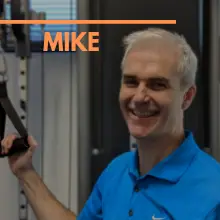Metabolic Syndrome
What is Metabolic Syndrome?
Metabolic syndrome (MetSyn) is a cluster of related metabolic abnormalities and risk factors that considerably increase the risk of developing type 2 diabetes and cardiovascular problems.
These include:
- Raised blood glucose (≥ 5.6 mmol/L)
- Raised blood pressure (≥130/85 mmHg)
- Dyslipidaemia (blood triglycerides ≥ 1.7 mmol/L and Lowered high-density [HDL-c] cholesterol)
- Central obesity (increased fat deposits around the abdominal organs).
The presence of 3 or 5 of these risk factors constitutes a diagnosis of MetSyn. About 19–29% of Australian adults have MetSyn.
How does exercise help?
Metabolic Syndrome can usually be reversed with lifestyle changes. The combination of weight loss and exercise produces the best effect.
Blood glucose levels, blood lipid levels and blood pressure all improve.
The risk of progressing to type 2 diabetes also reduces by 29–68% (3–5). This improvement may exceed the benefits of current diabetes medications.
Focus on ‘fitness’ rather than ‘fatness’
Although weight loss remains fundamental to the management of MetSyn, it is mistakenly thought of as the main reason for doing regular exercise.
Several major lifestyle intervention trials show that exercise leads to a significant reduction of risk factors even without weight reduction.
What exercise is best for people with MetSyn?
People with Metabolic Syndrome can exercise safely if the exercise program begins slowly and progresses appropriately. An accredited exercise physiologist can prepare an exercise program for people with MetSyn, who may also have other medical conditions.
The general recommendation for adults to participate in at least 30-minutes of aerobic exercise on most, if not all, days of the week holds for people with MetSyn. This is because improvements in glucose levels and insulin effectiveness can be lost within 24 to 48-hours of the last exercising.
Aerobic exercises that use the large muscle groups including the calf (e.g. brisk walking, jogging, cycling, swimming, dancing, playing ball games or other sporting activities) are appropriate and effective. A combination of aerobic exercise and progressive resistance training reduces the risk of progressing to type 2 diabetes. Use resistance exercise to complement, but not replace, aerobic exercise training.
For overweight and obese people, the recommended level of exercise can significantly reduce:
- waist measurement by 2–5 cm without weight loss
- lower systolic and diastolic blood pressure (by approximately 5.5 mmHg each)
- improve control of blood glucose levels
- lower blood lipids (by 0.2 - 0.3 mmol/L, up to 1.39 mmol/L)
- increase HDL-c (by 0.02 - 0.13 mmol/L, up to 0.20 mmol/L)
| Type | Intensity | Duration | Frequency |
| Aerobic Exercise (for heart and lung strength) | Moderate | At least 30 minutes | On at least 5 days per week |
| Resistance Training (muscle and bone strength) | Moderate
Up to 8 different exercises |
2-3 sets x 12-15 repetitions | At least 2 sessions per week |
References
PridePlus Health - Exercise Physiology https://prideplus.com.au/exercise-physiology/
PridePlus Health - For Referrers https://prideplus.com.au/referrers/
PridePlus Health - Blog https://prideplus.com.au/blog/
Exercise is Medicine Australia www.exerciseismedicine.org.au
Exercise Right www.exerciseright.com.au
1. Alberti KGMM, Eckel RH, Grundy SM, et al. Harmonizing the metabolic syndrome: a joint interim statement of the International Diabetes Federation Taskforce on Epidemiology and Prevention; NationalHeart, Lung, and Blood Institute; American Heart Association; World Heart Federation; International Atherosclerosis Society; and International Association for the Study of Obesity. Circulation 2009; 120:1640–45.
2. Zimmet PZ, Alberti K, Shaw JE. Mainstreaming the metabolic syndrome: a definitive definition. Med J Aust 2005; 183(4): 175–6.
3. Knowler WC, Barrett-Connor E, Fowler SE, et al. Reduction in the incidence of type 2 diabetes with lifestyle intervention or metformin. N Engl J Med 2002; 346(6): 393–403.
4. Tuomilehto J, Lindstrom J, Eriksson J, et al. Prevention of type 2 diabetes mellitus by changes in lifestyle among subjects with impaired glucose tolerance. N Engl J Med 2001; 344(18): 1343–50.
5. Laaksonen DE, Lindstrom J, Lakka TA, et al. Physical activity in the prevention of type 2 diabetes: the Finnish diabetes prevention study. Diabetes 2005; 54(1): 158–65.
6. Franz MJ, VanWormer JJ, Crain AL, et al.Weight-loss outcomes: a systematic review and meta-analysis of weight-loss clinical trials with a minimum 1-year follow-up. JAmer Diet Assoc 2007;107(10):1755–67.
7. Kay SJ, Fiatarone Singh MA. The influence of physical activity on abdominal fat: a systematic review of the literature. Obes Rev 2006; 7(2): 183–200.
8. Bin Ismail, I., Keating, S., Baker, M.K. and Johnson, N.A. A systematic review and meta-analysis of the effect of aerobic versus resistance exercise training on visceral fat. Obesity Reviews, 13(1): 68-91, 2012.
9. Marwick TH, Hordern MD, Miller T, et al. Exercise training for type 2 diabetes mellitus impact on cardiovascular risk: a scientific statement from the American Heart Association. Circulation 2009; 119(25): 3244–62.
10. Kelley GA, Kelley KS, Tran ZV. Aerobic exercise, lipids and lipoproteins in overweight and obese adults: a meta-analysis of randomized controlled trials. Int J Obes 2005; 29(8): 881–93.
11. Johnson JL, Slentz CA, Houmard JA, et al. Exercise training amount and intensity effects on metabolic syndrome (from studies of a targeted risk reduction intervention through defined exercise). Amer J Cardiol 2007; 100(12): 1759–66.
A PridePlus Health Case Study on Metabolic Syndrome
Background
“I’m embarrassed to exercise at the gym”
43 year old male with central obesity,
- Glu F of 6.1, Triglyceride 2.1, hypertension (BP 155/100)
Knee pain when squatting or stair climbing
Infrequent exercise, some walking, no structured plan
Goals
Increase walking for health and wellbeing
Reduce adipose tissue content
Reduce the intake of soft drinks
Engage in resistance exercises for 30 minutes 2 x days per week
Baseline Assessment
6-minute walking test at a speed of 3.0km / hr, HR = at 6-minutes 155BPM
Tightness in calves, altered walking gait
30-second sit to stand = 8
Program and Team
Referred by GP to EP for 5 x one on one consultations
Treatment over 12 weeks, initially weekly x 4 weeks, then 1 / 2 weeks at weeks 6, 8, 10, 12
Cardio - treadmill walking for 15-minutes at THR 120 - 140 BPM, stability and strength focus (5 exercises 3 x 10-12 reps), reassurance and support, goal-focused approach
Encouraged to use functional exercises at home and walking for 20 to 30-minutes after work 3 days per week
Home tasks performed 2 x week
Progress
Re-assessment at 6 weeks and 12 weeks:
6 Weeks:
- 6 minute treadmill test - 3km / hr HR = 147 BPM
- 30-second sit to stand: 11
12 Weeks:
- 6 minute treadmill test - 3km / hr 143 BPM.
- 30-second sit to stand: 13
Walking tolerance increasing, strength increasing, no knee pain when squatting and stair climbing.
Can perform 3 x 15 squats holding 6kg.
Outcome
“I feel more confident in my own ability and know what I can do”

“A structured exercise plan of cardio and resistance exercises enabled the client to understand his movement patterns, helped him gain confidence and improved his quality of life” - Mike Fitzsimon, Exercise Physiologist, PridePlus Health



